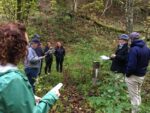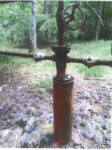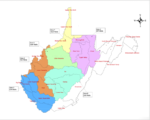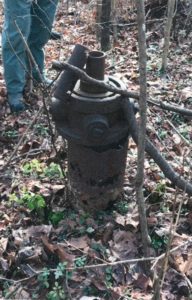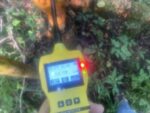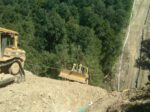- Like
- Digg
- Del
- Tumblr
- VKontakte
- Buffer
- Love This
- Odnoklassniki
- Meneame
- Blogger
- Amazon
- Yahoo Mail
- Gmail
- AOL
- Newsvine
- HackerNews
- Evernote
- MySpace
- Mail.ru
- Viadeo
- Line
- Comments
- Yummly
- SMS
- Viber
- Telegram
- Subscribe
- Skype
- Facebook Messenger
- Kakao
- LiveJournal
- Yammer
- Edgar
- Fintel
- Mix
- Instapaper
- Copy Link
First decide whether you want to go along with it or try to stop it.
Plugging an oil or gas well does create some construction-type mess and truck and equipment traffic. However, for reasons set out in more detail in our video on how a well is “plugged”, not “capped”, we highly recommend in most instances that you support the plugging. An unplugged well lowers your property’s value. The metal of the well casing of an unplugged well bore certainly will eventually rust etc., and although it does not always happen, when the casing goes bad or other problems occur, such an unplugged well has the potential to spoil your groundwater, to leak liquids out onto the ground, to leak methane responsible for climate change into the atmosphere — and to stink.
Who wants to plug the well and why?
First, West Virginia has lots and lots of old non-producing oil and gas wells orphaned by oil and gas companies who milked them for all they were worth, and then took the money and ran without plugging them. Through WVSORO’s work with the State Legislature, and now the federal Infrastructure legislation, there is lots of money to plug many (but not nearly all) of those wells that oil and gas drillers failed to plug before going out of business. (Because there are so many orphaned wells, it will probably be easy to get a plugger who is getting paid using State or federal money to plug the well to go plug a well elsewhere if you do not want the one on your land plugged.)
Second, drilling companies are statutorily required to plug their wells as the wells go out of production for 12 months. (The statute misleadingly calls these “abandoned” even though the driller may still be in business and have a bond on the wells, so we do not use that term. We call them “unplugged” or “non-producing”.) State enforcement of the plugging requirement is almost non-existent, so the companies are usually way behind in plugging wells that have not produced in 12 months. (If that is why a well on your land is being plugged, again you can probably persuade them to plug another of their wells they are supposed to have plugged elsewhere, but if they want to do so, they can plug the well on your land.)
Third, sometimes coal companies want to do long-wall mining in areas where oil and gas wells have been drilled. To avoid the difficulty of having to mine around these wells, and for the safety of coal miners, they want to plug the wells before mining. (You will be very unlikely to get the coal company to stop plugging a well on your land if they want to for this reason.)
Fourth, if an unplugged well is actually polluting somehow, then whoever complained about that will be able to have it plugged.
What if you are getting free gas?
The State cannot make a driller plug a well if you are getting free gas from it (unless the well is causing pollution). However, if the driller wants to choose to plug it even without the State requirement, the driller can do so (though if there is another well on the lease, you might be able to hook to the other well for your free gas). So the well owner can plug the well even if you are getting free gas. You could offer to buy the well to own it yourself in order to keep getting free gas if the well owner will sell it to you. But then you would have to post a $5000 bond and you would be liable for the additional thousands of dollars it would cost to plug the well at the end of its life or if it starts polluting. Some people do that, but the risk is only worth it if it is a good producing well with lots of producing, if only in small amounts, life left. And instead of you paying to buy the well, the seller should pay you to take it off their hands so they do not have to spend $10,000 or $20,000 or more to plug it!
So if the well is going to be plugged, what should you do?
If you decide to go along with the plugging, then you should try to positively influence surface concerns about how it is done and do what you can to assure that the down-hole plugging work is done right.
It is very likely that the plugger will come out to your land and look around, particularly at the original road, before filing an application for the State Department of Environmental Protection (“DEP”) plugging permit that the plugger must get. It is somewhat likely the plugger will contact you first to tell you they are coming onto your land. It is the decent thing to do, and it gives you some time to gather information and an early opportunity to make suggestions to their plans. The first dealings with the plugger are the easiest opportunities to get any changes in the plugger’s plans that you may want. Once they get their plans written down, they are less likely to change them to suit you.
However, they do not have to talk to you first. They are however required, (unless they get you to sign off on a “Voluntary Statement of No Objection” we talk about later), to serve you with a copy of the plugger’s application for a permit from the DEP. Part of the plugger’s permit application is a form that includes “INSTRUCTIONS TO SURFACE OWNERS NAMED ON PAGE WW4-A”. It starts on PDF page 4 of the blank forms attached. (The form may be a little modified from the attached but it will essentially be the same. It explains briefly how to comment if you want something on the driller’s plugging permit application plans changed. It explains that the DEP has the right to deny or condition the permit based on your comments, but maybe not on everything you would like to change. The two types of relevant comments that the State can use to deny or modify the permit are that “2)The soil erosion and sediment control plan is not adequate or effective” and also maybe “4)The proposed well work fails to protect fresh water sources or supplies.” Those are set out on the form along with others not so relevant to plugging.
If the first you hear about the proposed plugging is when you get served with a copy of the notice that the driller is applying for a permit to lug the land, you have to act very quickly! You only have 5 days to get your concerns in some comment form of writing to the State DEP! (We think that does not count weekends or holidays.) You should immediately call the DEP (304-304-926-0499) and ask them when your last day is to get comments filed for the permit on your land and how you can get the comments to them. Hopefully they will accept faxes in addition to letters. And note importantly that if there are more than three owners of the surface, then the plugger only has to give the permit notice papers to one of you, so be sure to contact the other owners – particularly if there is another owner that lives on/uses the surface.
This right to comment is your opportunity to try to influence what you don’t like about the plugger’s permit application. You should not pass up the opportunity to comment if in fact you want to have changes made to the plugger’s plans.
Usually, however, as noted above, before the plugger filed for a permit and you get it served on you, we expect the plugger will have someone come out and contact you. They may do so because they are genuinely interested in learning about potential issues on the land that you know about, and in accommodating you if they can, and in doing the right things on your land. But they may also be approaching you in order to get you to sign off on a “Voluntary Statement of No Objection” to their plans they have already put together, or maybe just as a blank check for plans they are working on. It saves them some time if you will sign the voluntary statement of no objection that would give up your right to comment. Hopefully they were decent enough to come out and talk to you before putting it together and you can negotiate what you want (and use as leverage your willingness to sign off on the voluntary statement of no objection if they do what you want). DO NOT sign off on anything that says you have seen the plans if you have not seen and been given a copy of the plans and are OK with the plans! If the plugger has listened to you and you are OK with the plans, it is OK to sign.
You will be most concerned about the driller’s surface use plans. You can have the right to comment on their down hole plugging plans, but that is very technical and the DEP does have experts on that who have to approve the plans,
Surface concerns.
Surface concerns include road reopening/location/maintenance/reclamation/abandonment.
Some unplugged wells still have usable roads to them. But there maybe alternative roads to the well you prefer. In addition, some roads were created before the State limited the slope of roads (or were put in after the requirement but violate the requirement). The maximum is now 20% — with special extra armoring of water bars with gravel, road surface, ditch lines etc. necessary if the road grad exceeds 15%. So an alternative road location to steep roads or extra erosion control may be an achievable goal. In addition, some long-unplugged old wells have roads that have been unused so long that trees have grown up in them or they have washed out or slid out. So again the construction of the road is an important issue and alternative routes to the old one may be reasonable.
It is also important how the road is maintained during the plugging, and whether gates enclosing farm animals or keeping strangers out will be honored or installed and kept closed.
Once the plugging is finished, it is important whether the road will be totally reclaimed back to original contour or just reclaimed to a usable road, and you may have a preference on that. Some people like roads on their land opening up portions their land that otherwise are not very accessible. If a usable road is to be left behind, it is very important to have one that will not have erosion and rutting, and one that can be securely gated if that is what you want. Steep roads are a particular problem that need properly dealt with as the plugger leaves to avoid washouts. No one with a road still on their land wants it washing out onto other parts of their land. Look especially at the water bar or broad-based dip requirements in the Erosion and Sediment Control Field Manual discussed below and make sure adequate numbers of these features are in the plan and are implemented. Other landowners do not want an avenue for strangers on four-wheelers and want the road permanently blocked with piles of dirt or big rocks etc., or even returned to original contour.
The reclaiming of the well site itself is also an issue. The surface from which the well itself was located cannot be buried – in fact there will be a 4-foot metal pipe monument showing its location in order to avoid, and in case of, future problems. But some of the pad area can be returned to original contour or not. And they can use seeding mixes that will be most likely to take root, or you can request wildlife or other preferred seeding mixes that may not be as quick to take root, but have other benefits. You want to insist before you sign off on anything that it provides that whatever is planted has to still be there growing after a year!
Your legal rights on these surface issues come from two sources.
First source of legal rights.
First, the State has an Erosion and Sediment Control Field Manual that the pluggers must follow. You can get a copy from our website or contact the State Department of Environmental Protection. We recommend you get/printout a copy and have it under your arm when you talk to the plugger so they will know that you know something about what you are talking about. The inspector from the Office of Oil and Gas is supposed to help you get the requirements of that Erosion and Sediment Control Field Manual enforced, but there are only 9 or maybe 18 of them for 75,000 wells in West Virginia. Never-the-less if you think there is a problem and the plugger won’t deal with it, you should call the State DEP oil and gas inspector for your county. Scroll down toward the bottom of this web page and look for your county and you will find the inspector’s name and cell phone.
For other permits related to oil and gas drilling, the driller has to submit a written reclamation plan with the permit application drawn up to show how the road and well site should be constructed and maintained and reclaimed. That plan has to be approved by the State and is for the workers to know how to do it. For wells being plugged with federal Infrastructure money, there will be a reclamation plan. Unfortunately, for plugging permits that are not funded by the federal money, a written plan does not have to be submitted (though it sometimes is included with the permit application anyway). So the workers have nothing to go by and very few of the workers, such as those running the bulldozers, have ever seen or even heard of the Erosion and Sediment Control Field Manual. And they are concerned most with whether the road is usable by them and not whether it will wash out later.
Again, before the work begins you will be served with a copy of the plugger’s application to the State DEP for the permit to plug the well. For plugging paid for by federal Infrastructure money ( and hopefully some of the other plugging) part of the plugger’s permit application is a form labeled at the top left “WW-9″. It is the reclamation plan. It starts on PDF page 6 of the blank attached. When you get served with that, or when the plugger approaches you with that, make sure that the plans on that form live up to the requirements in the Erosion and Sediment Control Field Manual. The Manual requirements are probably not something that the plugger has always complied with. So make sure and push on the details of this. And if the plans do not comply with the manual, do not sign off on anything, and get ready to comment to the State.
So you should look to see if there is a reclamation plan with the permit application that you are given, and if there is, make sure it complies with the Erosion and Sediment Control Field Manual. You should try to see what kind of water/drainage barriers are set around the pad. And in particular you should see how many water bars and other features should be required on your road after they are done. If there is no plan, then ask them if they agree with what you think the Erosion and Sediment Control Field Manual requires for your road etc. You are trying to get them to understand that following the Erosion and Sediment Control Field Manual is what they need to do and you want it done that way.
Probably the two largest concerns are the way the road is left with proper number and design of water bars or broad-based dips and other drainage features after the plugger leaves, plus the seeding mix that is used. If you are approached before being officially served, make sure to tell the plugger to do the road to comply with the Erosion and Sediment Control Field Manual as the plugger leaves. If the road starts to wash out later, it will be very hard to get the company back. Also make sure it will have the seed mixture you want. If the first contact you have is when you get served with the official notice of the permit application, remember YOU ONLY HAVE 5 DAYS TO COMMENT to the State to get it in compliance with road requirements, and to get the seed mixture you want. The DEP has an approved wildlife mixture that is not as sure to germinate and grow, but has other benefits. Some farmers say that the mixture used by drillers, though it is most likely to germinate and grow, can affect the health of pregnant farm animals.
The State requirements in the DEP’s Erosion and Sediment Control Field Manual are mostly about HOW roads and well pads are constructed. If you would rather have a road on the edge of your field instead of through the middle – issues like that – using the Erosion and Sediment Control Field Manual and trying to use State enforcement cannot help you directly. As long as it is done right, the State will not help with issues like where, unless the purpose location is inherently a soil erosion and sediment control problem or a water pollution problem. You need to use the second source of legal rights.
The second source of legal rights.
Your second source of legal rights has two sub-sources. Which sub-source of your legal rights depends on whether you also own all or a share of the minerals or not.
If you own a share of the minerals, then in order to drill the well, the driller had to have gotten a lease from you or from a predecessor/ancestor.
(If the well was drilled after 2018 or 2022 and the driller got the consent of 75% + of the interests, then the cotenancy statute or the forced unitization statute may have been used to get the right to drill your 25% – interest. It is unlikely wells drilled using those statutes are ready to be plugged. If that is happening, call us for help).
The lease that enabled drilling of the well will sometimes have language that gives the care that the driller/plugger has to use when drilling on your land. The lease will be recorded in the courthouse under the name of you/your predecessor and/or the name of the current well owners or the current well owner’s predecessor. (Because the lease has probably passed through generations or several hands, these can be hard to find. You can always ask the plugger for a copy but there is no requirement that they give it to you.)
Usually nothing specific is stated in the lease other than having to stay 200 feet from a dwelling etc., then the common law says that the plugger has to do things as a “prudent operator” would do them. So in discussions and arguments with the plugger about how the surface is going to be treated, you can throw those words around. “You have to do what a prudent operator would do!”
The lease is the first possible sub-source of your legal rights. If you do not own a share of the minerals, your second source of legal rights is a sub-source of rights called the “reasonably necessary” rule of common law.
Under the reasonably necessary rule in common law, the mineral owner (and that mineral owner’s driller/operator/plugger) has the right to reasonably necessary use of your land to get at the minerals underneath. But they have ONLY the right to do what is NECESSARY and to do it REASONABLY. So in discussions and arguments with the plugger about how the surface is going to be treated, you can throw those words around. “You only have the right to do what is reasonably necessary, and I do not think that a judge would say that what you are doing is not (necessary or reasonable)!”
Unfortunately, enforcing either of these second sources of your legal rights that means going to court. That usually means getting a lawyer, though if you get an estimate for fixing what they do wrong, you could sue on your own in Magistrate Court.
Take care of these surface concerns first by dealing with the plugger, and if that does not work, but filing comments with the State. Most of what you can do about down-hole plugging concerns happens once the plugger gets started.
Down-hole Plugging Concerns.
Before you read this, if you have not done so already, you need to view this slide show on how plugging is supposed to be done and what can go wrong if it is not done right – and how easy it is for the driller to cheat without getting caught taking shortcuts. And again that slide show suggests as background to that slide show for you to view this slide show for additional details of how a well is drilled and cased with steel casing and cement in the first place.
As we said above, before the work begins you will be served with a copy of the plugger’s application to the State DEP for the permit to plug the well.
Another part of the plugger’s application for a permit is labeled at the top left “WW-4B”. It is at PDF page 3 of the set of plugging application forms. Part of that form is (maybe section 10) the “work order” that explains which metal tubing and casing is going to be cut off at the bottom and pulled out of the well. And it will tell where cement and clay are going to be inserted into and left in the well bore to keep the gas from coming up and to keep whatever is in the formations above from getting into other formations etc. etc. It is far beyond the scope of this web page to fully explain how to read and understand that. So instead, again if you have not already, start by looking at our slide show about plugging. Try to match what that slide show says is going to happen with what you find in the work order, though the work order is likely to contain more steps than our simplified slide show.
We think you will find that difficult to understand. But we think that the DEP will do a pretty good job of making sure that the plans are good plans. However, we are VERY concerned about the lack of oversight of whether the plans will be followed and other down-hole plugging issues by the very few DEP inspectors and other oversight. So our thought on maybe the best way to proceed is as follows:
- Once the pluggers show up with their equipment, go to the work site frequently. You have a right to be there (as long as you stay off the machinery). And there is very little serious danger.
- Keep a diary or journal each time you go out to the site or even just talk to them – start with when they first contact you. (You may think you will remember who you talked to when about what, but that has not been our experience.)
- Keep the drilling permit (along with the Erosion and Sediment Control Field Manual) under your arm where they can see them to give some semblance at least that you know what you are looking for.
- Take lots of pictures and videos with your phone every time. Taking pictures is cheap these days, and pictures are hard to argue with. Be sure to take some from far back in addition to some from closer. If you think they are doing things differently when you are not there, set up a trail camera or something similar.
- Importantly, when you get there each time, ask the plugger what stage they are at and what they are doing. There is sure to be one person in charge at the site all the time. Find out who it is. If this is a federally funded plugging job one of the individuals on the job will be the company’s official designated “compliance officer”. This person should always be able to tell you what is going on.
- At some point ask them if you can have a copy of the affidavit they turn into the state when they are done.
We hope doing these visits and pictures etc. will deter the plugger from taking improper shortcuts. Sometimes they do run into problems, like cave-ins and things breaking off down-hole, that means they have to change from what they originally planned to do. Sometimes they have to get DEP approval for changes. And yes, if they are determined, they may be able to take shortcuts without you knowing it despite our suggestions. But we think having you watch what they are doing will be some significant deterrent.
Some tips on contacting the pluggers workers and bosses: Be friendly to all the workers and introduce yourself and talk about the weather, garden, hunting, sports etc. As is the best practice anytime you are dealing with a company or agency, get names – at least first names. Do not get upset at the person you are contacting if that person you are talking to does not give you satisfaction. Having them dislike you will rarely get you anywhere, and in this situation you do not have much outright authority to hold over their heads. Instead just ask for the name and number of their supervisor. That might get you what you want from the person you are talking to, and if not you might get it from the supervisor. And then if talking to the company does not get you satisfaction, or if they will not give you the name of the supervisor, call the State DEP oil and gas inspector for your county. Scroll down towards the bottom of this web page and look for your county and you will find the inspector’s name and cell phone.
Conclusion.
Plugging unplugged oil and gas wells has long been neglected by the oil and gas industry in this State and nationwide. It needs to be done. Our Legislature has not made it possible to effectively require the drillers who make the money off the wells to plug them when they should be plugged. As a result we have 6,500 orphaned wells, and we expect another 10,000 over the next 30 years. So join WVSORO to help us get the Legislature to enact laws to prevent future orphans. Or if you have found this web page helpful, you can just donate to us.
And if you have more questions about plugging being done on your land, be sure to contact us with your questions.


